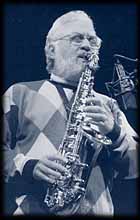
|
|
|
|
|
|
Photo Credit: Tim Owens |
Lee Konitz
Pioneering jazz musicians often have the most engaging personalities, and alto saxophone sensation Lee Konitz is no exception. Konitz joins Dr. Taylor and his trio to perform wide variety of styles ranging from “free” improvisation to swinging reinterpretations of jazz standards. Cheerful reminiscing on the part of these two masters of jazz further enhances this wonderful evening of music and conversation A native of Chicago, Konitz is among an illustrious group of musicians who participated in the 1949 recording sessions that became known as the Birth of the Cool. These historic sessions also included trumpeter Miles Davis, arranger Gil Evans and saxophonist Gerry Mulligan, among other players and composers. Konitz’ entry into this esteemed group of artists originally came about through his stint with the Claude Thornhill band, for which Gil Evans served as chief arranger. Konitz' approach to the alto sax was ideally suited to the goals of the “cool” movement, which was a more relaxed and subdued improvisational style than bebop. At the time, bebop saxophonist Charlie Parker was a dominant influence, as droves of saxophonists strove to imitate his rapid-fire, virtuosic style. Though Konitz consciously pioneered a more laid-back approach, he downplays his own innovation in deference to Parker's tremendous skills. When Dr. Taylor asks Lee how he managed to develop a style so distinct from Parker at the height of the latter’s influence, Konitz chuckles, "[Parker’s approach] was too difficult for me" Another of Konitz’ key liaisons was with the influential pianist Lennie Tristano. Konitz tells Billy that he first "played in a cocktail lounge with Tristano in about '46." He elicits laughter from Dr. Taylor and the audience by recalling a rotating circular bandstand on which they once played together. The mechanical bandstand was disconcerting because "it had a hitch in it," Lee explains. This early encounter with Tristano occurred when Konitz was an aspiring teen musician in Chicago. Tristano convinced Konitz that his career in music should involve artistic exploration, and that his potential extended beyond that of a journeyman. Konitz reunited with Tristano in the mid-50s when they made a series of recordings together. As demonstrated throughout the evening, Konitz’s sound is smooth, mellow and rich, with a quizzical, somewhat probing attack. Musical selections include a line he calls "Subconscious-Lee," which is based on the chord changes of the more familiar "What Is This Thing Called Love." The classic ballad "Body & Soul" again displays Konitz ability to substitute and surround a melody in a slightly off-centered manner. Other numbers include a freely improvised group piece, an unaccompanied rendition of "The Song is You," as well as "Star Eyes" and "I'll Remember April." During the audience participation portion of the show, an audience member asks Lee if he ever has ideas in his head that he can't reproduce in the course of improvising. Konitz replies, "Frequently...I just had some…," eliciting laughter from the audience. Another question deals with Konitz’ frequent tours of Europe, where he says the jazz scene is "developing very well" During one whimsical exchange, Billy suggests that Lee's style does not utilize vibrato. Lee humorously disputes the point; picking up his horn, he announces, "Vibrato, ladies and gentlemen." After this demonstration, Billy laughs and says, "I stand corrected." As usual, everyone learns something new in this comfortable setting, as the musicians and audience interact freely throughout an evening of outstanding music.
Don't miss Lee Konitz in our Photo Gallery!
|
|
| |

